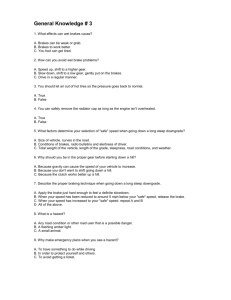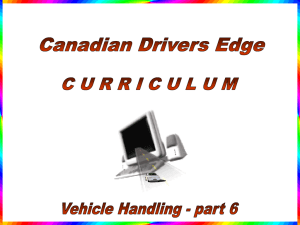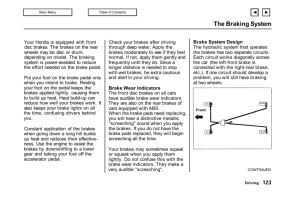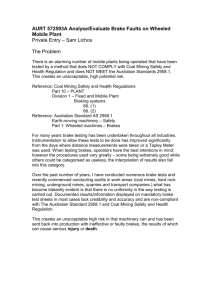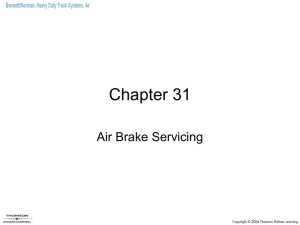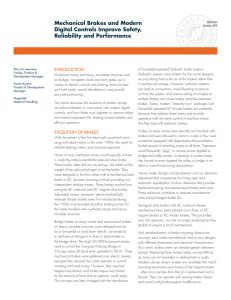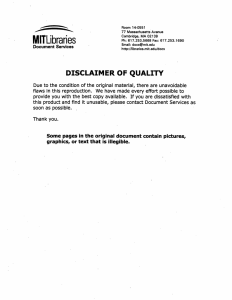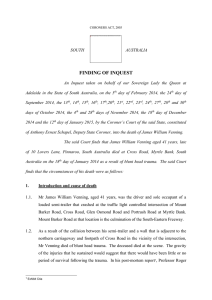What should you do in this situation?
advertisement
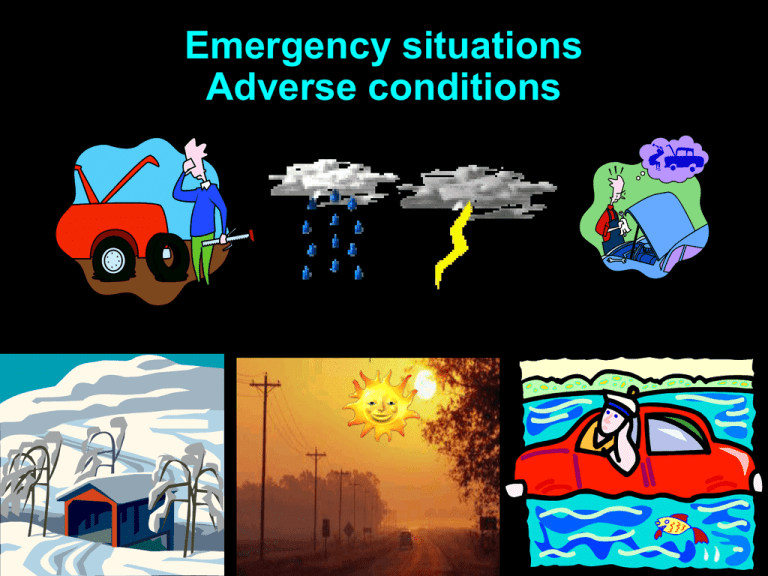
Emergency situations Adverse conditions Everything is harder to see. What effect STOP dirty Itwould woulda make windshield everything andmuch have with harder to see THINK sun glare? What are some problems associated with sun glare? What could she do to minimize the direct sun glare? Drop the sun visor. Also, be aware of sun glare upon drivers when you are a pedestrian. It’s likely this driver would have a hard time seeing you if you were to begin crossing the street. As the sun begins to set, don’t forget to________________________. Also, in rainy weather you must use your __________. What about your following distance in rainy weather? Double or triple it. What is a problem following large trucks in rainy weather? Their large tires throw it all on our windshield. Be sure you have a good supply of window washer. What is a problem following large trucks in rainy weather? Sometimes it can really be difficult to see! Roadways are most slippery when it: ___________________ Roads accumulate dirt and oil which mix with the first few minutes of a rain causing a pasty gooey substance that is very slippery. After some heavier rain, this “summer ice” is washed away. Be careful of sudden movements with the steering wheel, quick acceleration, or hard braking. What is important to remember when going through shallow water? Hydroplaning is possible. Keep moving slowly. What is important to remember when going through deep water? • Keep moving slowly • Dry your brakes when through the deep water How do you dry wet brakes? - one foot on gas…one foot applying pressure to brake What are some mountain driving strategies? Black ice: patches of • ice Reduce speed that are difficult • toWatch lanefrom differentiate dry blacktop. It forms position when the ground around temperature curves is lower than 32 degrees but the air is for warmer, • Watch allowing “blackmoisture ice” to collect and then freeze. In Motion magazine, a General Motors publication What is black ice? This message is especially for trucks. However, if you do a lot of mountain driving, its good to downshift because it will prolong the life of your brakes. It would be wise to____________. What does this sign mean? In addition to larger trucks, what other vehicle could tip? Possible rollovers Reduce speed on curves False, hold it down firmly. TRUE or FALSE: When using Antilock brakes, pump the brake pedal. In Motion magazine, a General Motors publication Without ABS: wheels lock up…no steering control Strategies in the Snow Perhaps the most important thing about driving in snow is to __________________________ On this one way street what are you searching for? Cars or pedestrians obscured behind large snow piles. You’re turning right at the intersection. What is a concern that you have? The slippery turning surface. Also, is another car coming? Slow down before the turn, more than you feel is necessary. Then, coast around the turn (stay off gas and brake). Do not accelerate until you straighten out. What are three important things you must do to make this right turn safely? You are on a wet road intending to turn right. What do you notice about the turning surface? Should this car attempt to pull out quickly, it would probably ________its wheels. How should you ease up at this intersection to see properly? Very slowly with your foot covering the brake. Should you become stuck in some deeper snow, how should you attempt to become unstuck? Try rocking the car, shifting from drive to reverse. You are not paying attention as this curve approaches. Your back end begins skidding to the right. You have antilock brakes. What do you do? Hold the brake pedal down hard, while steering quickly to the right. Also, be ready to counter steer while keeping your eyes focused on where you want to go. What are some things you should remember about driving in fog? Use low beam lights Reduce speed Increase following distance If very bad get off road In Motion magazine, a General Motors publication Where is it more likely to be foggy? In low lying areas, costal regions and by lakes. Sometimes it can be very thick…slow down! First, SHIFT TO A LOWER GEAR. Then, quickly pump the brake pedal 3-4 times. (try to restore pressure) If pressure is not restored, use the emergency / parking brake. You press on the brake pedal to start stopping, but the pedal goes right to the floor. You have no brakes! What three things should you do? The right rear tire blows out! What do you do? In Motion magazine, a General Motors publication 1st Firm up your grip on the wheel. 2nd Ease up on the accelerator. 3rd Check traffic. 4th Drive off the roadway and brake gently. 5th Turn on the emergency flashers. W What should you do in this situation? W What should you do in this situation? 2) Apply the brake. 1) Ease off gas. 3) Turn on emergency flashers. The hood usually flies up because it was not properly latched. 1st Look through the crack below the open hood or look out the window if you can’t see under the hood. 2nd Turn on the emergency flashers to warn other drivers. 3rd Slow down, and drive off the roadway to a safe location. Ease off accelerator, then gradually turn the wheels back onto pavement. Do not brake hard and do not jerk the wheel to the left. If you’re not paying attention and you drop your wheels onto the shoulder, what should you do and not do? NEUTRAL Shift to ___________and attempt to restart it What should you do if your car suddenly stalls (engine dies out) while driving? (the traffic is light) Shift to neutral & attempt to un-stick it with foot. If unsuccessful, brake, pullover and shut off engine. What if the accelerator sticks and the car keeps going faster and faster. (the traffic is light) Driving in hot/windy weather In hot weather, the engine may ______________ What are the symptoms? - temperature light glows or gauge runs hot - possible white smoke from hood What should you do when this occurs? Turn off air conditioner; turn on heater and fan. If white smoke appears, pull off road and shut off car. Driving hot/windy weather What are in some problems that can occur with very high winds? Avoid driving taller vehicles like recreational campers or trucks because they have a greater susceptibility to tipping in strong winds. Even smaller vehicles can be pushed into an on-coming lane. Also, be aware of the wind created by large trucks as they pass by. In some open field areas, high winds could cause dust over the road causing a slippery situation. BEWARE OF DUST OVER ROAD 1st Quickly steer the car out of traffic and off the road way to a safe area. 2nd Have all passengers get out of the car and move at least 100 ft way from the car. 3rd Estimate how serious the car fire is and move away from the car and wait for the fire department. A car fire can be caused by fuel, oil, grease, or electric equipment. A car might stall on the tracks if it’s going too slow (especially stick shift cars) 1st If no train is coming try to restart the car. 2nd If you cannot restart the car, have all passengers get out. 3rd Shift to neutral and push the car off the tracks. 4th If a train is coming exit your car and run away in the direction that the train is coming from. Sleepy drivers are one of the greatest hazards on nighttime roads. What are some temporary ways of staying awake? In Motion magazine, a General Motors publication 1)1) As the sun begins to set, don’t forget to: ______________ 1)2) True or False: If it’s raining use low beam lights and at least double your following distance. _____ 1)3) True or False: Adding a loaded car top carrier to your vehicle can help stabilize your vehicle on curves. _______ 1)4) Roadways are most slippery when it ________________ 1)5) When driving down steep mountain roads, to help save your brakes and control your speed _________________ 6) The most important thing about driving in snow is to: ____________________________________ 1)7) The best way to turn on a snow covered road is to slow down before the turn and then _______________________ 1)8) True or False: When using anti-lock brakes (ABS) on icy roads, pump the brakes for greater effectiveness. ______ 1)9) If you attempt to pull out quickly on a icy surface you will probably just ______your wheels 1)10) If on an icy road your back end begins skidding to the left, you should turn the wheel to the _____. If you have ABS you should hold the brake pedal down __________ 1)11) Two things to remember when driving in fog: _______________________________________ 12) If your brakes fail, besides pumping them to try building up pressure again, also: ____________________________ 1)13) If you experience a tire blowout be careful not to apply _______ right away. Also ______up your grip on wheel. 1)14) True or False: There are potential dangers and risks in picking up hitchhikers & in some states its illegal._______ 1)15) If your car stalls while moving, shift to ________and attempt to ________ the engine. 1)16) If the accelerator sticks, (in very light traffic) the first thing you do is ___________then try to lift it up with foot. 1)17) Your right wheels drop off onto the shoulder, what should you do: ___________________________________ 18) What should you first try if you feel your engine is running hot: _____________________________________
